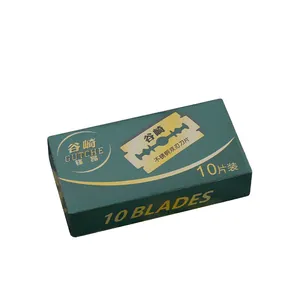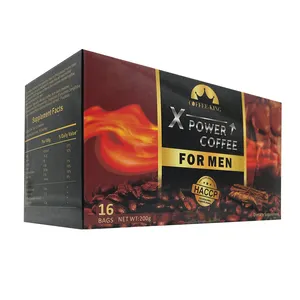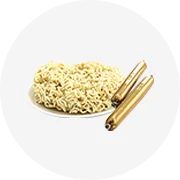Phổ biến trong ngành của bạn

Lưỡi Dao Cạo Bằng Thép Không Gỉ Lưỡi Cạo An Toàn Thẳng Lưỡi Dao Cạo Một Cạnh 100 Gói
32.579 ₫ - 45.814 ₫
Đơn hàng tối thiểu: 500 Hộp
Vận chuyển mỗi chiếc: 12.217 ₫


Lưỡi Cạo Bằng Thép Không Gỉ Độ Chính Xác Tốt Nhất Lưỡi Cạo Cạnh Đơn
764 ₫ - 1.273 ₫
Đơn hàng tối thiểu: 3000 Cái


Thiết kế mới Mens kim loại thép không gỉ đôi cạnh lưỡi dao cạo an toàn dao cạo cho khuôn mặt navaja de afeitar
56.250 ₫ - 67.194 ₫
Đơn hàng tối thiểu: 5 Cái


Phụ Nữ Lông Mày Dao Cạo Cho Đa Năng Tẩy Tế Bào Chết Dermaplaning Tool Cắt Tỉa Và Cạo Grooming Lông Mày Mặt Dao Cạo
2.800 ₫ - 5.091 ₫
Đơn hàng tối thiểu: 10 Cái


Dao Cạo An Toàn Rose Gold Light Phong Cách Sang Trọng Straight Double Edge Blade Hợp Kim Nhôm Xử Lý Dao Cạo An Toàn
67.957 ₫ - 71.012 ₫
Đơn hàng tối thiểu: 5 Cái


Lưỡi Dao Cạo An Toàn Hai Cạnh Bán Sỉ Từ Nhà Máy Lưỡi Dao Cạo Bằng Thép Không Gỉ
510 ₫ - 764 ₫
Đơn hàng tối thiểu: 50000 Cái

Lưỡi Dao Cạo Cạo Lưỡi Thép Không Gỉ An Toàn Dùng Một Lần Cho Salon Hai Cạnh Cho Nam Cạo Râu Hàng Ngày
Sẵn sàng vận chuyển
510 ₫ - 1.019 ₫
Đơn hàng tối thiểu: 200 Cái
Vận chuyển mỗi chiếc: 1.273 ₫

Duy Nhất Cạnh Lưỡi Zero Chất Thải Lớp Phủ Crom Thép Không Gỉ An Toàn Dao Cạo Lưỡi Cắt Tóc Sử Dụng
255 ₫ - 764 ₫
Đơn hàng tối thiểu: 50 Cái

Nhựa Duy Nhất Giá Rẻ Cạnh Lưỡi Dùng Một Lần Cạo Râu Dao Cạo Lưỡi Thép Không Gỉ Maquinilla De Afeitar Desechable
1.019 ₫
Đơn hàng tối thiểu: 100000 Cái

10 Cái/hộp Thép Không Gỉ Single Edge Dùng Một Lần Tóc Razor Bblades Barber Cạo Razor Blades C6000
Sẵn sàng vận chuyển
23.671 ₫ - 28.252 ₫
Đơn hàng tối thiểu: 1 Hộp
Vận chuyển mỗi chiếc: 188.346 ₫

Chất Lượng Cao Biểu Tượng Tùy Chỉnh 100 Pcs Duy Nhất Cạnh Cổ Điển Sliver Lưỡi Dao Cạo Thép Không Gỉ Lưỡi Dao Cạo Cho Nam Giới
50.396 ₫ - 73.302 ₫
Đơn hàng tối thiểu: 100 Cái

Sharp An Toàn Barber Nhật Bản Thép Không Gỉ Cạo Single Edge Razor Blade Men
1.528 ₫ - 1.782 ₫
Đơn hàng tối thiểu: 10000 Cái
Các tìm kiếm liên quan:
lưỡi dao cạo thép nhật bảnlưỡi dao cạo thép carbon đôi cạnhlưỡi dao cạo đôi cạnh bằng thép không gỉlưỡi dao cạo hai cạnh không gỉlưỡi dao cạo personnalưỡi dao cạo bằng thép không gỉlưỡi dao cạo tênlưỡi dao cạo wilkinsonlưỡi dao cạo pháplưỡi dao cạo cạnh bằng thép không gỉlưỡi dao cạo hai lưỡilưỡi dao cạo billielưỡi dao cạo chúabán buôn dorco dao cạo lưỡilưỡi dao cạo henry

Lưỡi Cắt Tóc Cắt Tóc Logo Tùy Chỉnh Cho Tông Đơ Cắt Tóc FX707 Thay Thế Bằng Thép Không Gỉ Bền Bằng Kim Loại Cho Tiệm Cắt Tóc
109.444 ₫ - 132.351 ₫
Đơn hàng tối thiểu: 120 Bộ
Vận chuyển mỗi chiếc: 8.400 ₫

Bộ Thẻ Giấy Cạo Râu Tốt Hơn Bộ Dụng Cụ Chăm Sóc Nam Hai Lưỡi An Toàn Lưỡi Dao Cạo Bằng Thép Không Gỉ
510 ₫
Đơn hàng tối thiểu: 1 Cái

Thép Không Gỉ Barber Straight Razor Double Edge Lưỡi An Toàn Có Thể Thay Thế Dùng Một Lần Barber Razor Blade
20.108 ₫ - 25.198 ₫
Đơn hàng tối thiểu: 10 Cái

Cửa Hàng Cắt Tóc Nguồn Cung Cấp Yếu Tố Cần Thiết Các Mặt Hàng Cắt Tóc Lưỡi Dao Cạo Gấp Không Gỉ Teel Cạo Râu Cạnh Duy Nhất Người Đàn Ông Cắt Tóc Dao Cạo Thẳng
22.398 ₫ - 31.816 ₫
Đơn hàng tối thiểu: 10 Cái
Vận chuyển mỗi chiếc: 155.003 ₫

Tùy Chỉnh Dùng Một Lần Cắt Tóc Nửa Lưỡi Dao Cạo Thép Không Gỉ Duy Nhất Cạnh Lưỡi Dao Cạo
255 ₫
Đơn hàng tối thiểu: 300000 Cái

Thép Không Gỉ Single Edge Tóc Dùng Một Lần Dao Cạo Blades B-01
Sẵn sàng vận chuyển
432.685 ₫ - 509.041 ₫
Đơn hàng tối thiểu: 5 Hộp
Vận chuyển mỗi chiếc: 310.515 ₫

Dao Cạo Thẳng Thép Không Gỉ Barber Salon Cạo Râu Dao Cạo Xử Lý Tiếp Xúc Với Lưỡi
19.090 ₫ - 101.809 ₫
Đơn hàng tối thiểu: 1000 Cái

Lansky Bán Buôn Barber Cạo Mens Thép Không Gỉ An Toàn Nửa Cạnh Duy Nhất Lưỡi Dao Cạo
815 ₫ - 1.146 ₫
Đơn hàng tối thiểu: 10000 Cái

Chuyên Nghiệp Thẳng Cạnh Cắt Tóc Dao Cạo Cắt Tóc Tạo Kiểu Tóc Cao Cấp Lưỡi Thép Không Gỉ Cho Việc Định Hình Kết Cấu Lớp
171.547 ₫ - 172.565 ₫
Đơn hàng tối thiểu: 100 Cái

Bán Sỉ Lưỡi Dao Cạo Một Nửa Cạnh An Toàn Bằng Thép Không Gỉ Cho Nam Cạo Râu Cắt Tóc
3.309 ₫ - 5.345 ₫
Đơn hàng tối thiểu: 200000 Cái

Thép Không Gỉ 420J2 Lưỡi Dao Cạo Công Nghiệp Cạnh Đơn
Sẵn sàng vận chuyển
764 ₫ - 2.800 ₫
Đơn hàng tối thiểu: 100 Gói
Vận chuyển mỗi chiếc: 136.423 ₫

Thép Không Gỉ Làm Sắc Nét Dùng Một Lần Dao Cạo Thẳng Lưỡi
Sẵn sàng vận chuyển
12.217 ₫ - 17.817 ₫
Đơn hàng tối thiểu: 50 Gói
Vận chuyển mỗi chiếc: 57.013 ₫

Đôi lưỡi dao cạo cạnh Salon sử dụng cạo Old-Fashioned Shaver Blade 10 miếng gói lưỡi thép không gỉ
Sẵn sàng vận chuyển
10.181 ₫ - 12.727 ₫
Đơn hàng tối thiểu: 10 Gói
Vận chuyển mỗi chiếc: 134.387 ₫

Dụng cụ cạo râu bằng tay lưỡi dao cạo của nam giới lưỡi dao cạo bằng thép không gỉ 24 cái/hộp lưỡi dao cạo một mặt Sẵn sàng vận chuyển
Sẵn sàng vận chuyển
 Sẵn sàng vận chuyển
Sẵn sàng vận chuyển139.987 ₫
Đơn hàng tối thiểu: 1 Cái
Vận chuyển mỗi chiếc: 110.208 ₫

Dao Cạo Thẳng Cho Thợ Cắt Tóc Thép Không Gỉ Chất Lượng Cao Để Cạo Một Lưỡi Cắt Cổ Lưỡi Cắt Tóc Tùy Chỉnh
40.724 ₫ - 50.650 ₫
Đơn hàng tối thiểu: 50 Cái

Ngọc trai Max bán buôn Hot Bán siêu thép không gỉ cạnh duy nhất Barber Blade cho Saloon
293 ₫ - 357 ₫
Đơn hàng tối thiểu: 200000 Cái

Thép Không Gỉ Và Gỗ Cạo Razor Men Cạo Dao Râu Chuyên Nghiệp Bánh Mì Gấp Thẳng Razor Single Edge Blade
63.631 ₫ - 83.992 ₫
Đơn hàng tối thiểu: 10 Cái

Lưỡi Dao Cạo YINGJILI Lưỡi Dao Cạo Đơn Thép Không Gỉ Lưỡi Dao Cạo
Sẵn sàng vận chuyển
14.508 ₫ - 17.817 ₫
Đơn hàng tối thiểu: 2 Bộ
Vận chuyển mỗi chiếc: 413.596 ₫

Thẳng cạnh thép không gỉ dao cạo cho nam giới Vàng dao cạo cắt tóc Nguồn cung cấp dao cạo thẳng vẻ đẹp cụ dùng một lần lưỡi
50.905 ₫ - 127.261 ₫
Đơn hàng tối thiểu: 10 Cái

Lưỡi Dao Chuyên Nghiệp Bằng Thép Không Gỉ Có Tay Cầm Thẳng Bằng Nhựa Lưỡi Dao Cạo An Toàn Cho Salon Một Cạnh Schick
78.647 ₫ - 106.645 ₫
Đơn hàng tối thiểu: 12 Cái

Tái chế công nghệ gỗ xử lý gấp dao cạo đơn cạnh thẳng lưỡi cho nam giới/cơ thể của phụ nữ sử dụng thép không gỉ cho tiệm hớt tóc
Sẵn sàng vận chuyển
77.629 ₫ - 100.536 ₫
Đơn hàng tối thiểu: 3 Cái
Vận chuyển mỗi chiếc: 73.557 ₫

Tùy Chỉnh Bao Bì Thép Không Gỉ Thẳng Cạnh Người Đàn Ông Của Lưỡi Dao Cạo Lưỡi Dao Duy Nhất Cho Khuôn Mặt Cơ Thể Gấp Cắt Tóc Dao Cạo Râu
85.265 ₫ - 98.245 ₫
Đơn hàng tối thiểu: 30 Cái

Thép Không Gỉ Barber Straight Razor Double Edge Lưỡi An Toàn Có Thể Thay Thế Dùng Một Lần Barber Razor Blade
39.451 ₫ - 49.632 ₫
Đơn hàng tối thiểu: 50 Cái

Dụng Cụ Giữ Thẳng Cho Thợ Cắt Tóc Phụ Kiện Làm Đẹp Cho Salon Máy Cạo Râu Chăm Sóc Cá Nhân Lưỡi Đơn Bằng Thép Không Gỉ Có Thể Điều Chỉnh Cho Nam
31.816 ₫ - 63.631 ₫
Đơn hàng tối thiểu: 10 Cái

4D W47-2 nhà máy thẳng lưỡi dao cạo thép không gỉ thay thế lưỡi dao cạo
Sẵn sàng vận chuyển
63.631 ₫ - 81.447 ₫
Đơn hàng tối thiểu: 100 Hộp
Vận chuyển mỗi chiếc: 10.945 ₫

Dao Cạo Y Tế Siêu Inox Dùng Trong Bệnh Viện Dao Cạo Phẫu Thuật Một Lưỡi Dao Cạo Y Tế Kèm Lược
764 ₫ - 1.273 ₫
Đơn hàng tối thiểu: 100 Cái

Bán Sỉ Lưỡi Dao Cạo Cắt Tóc Một Cạnh Bằng Thép Không Gỉ Nhập Khẩu Logo Theo Yêu Cầu Chất Lượng Cao 100 Dành Cho Thợ Cắt Tóc Chuyên Nghiệp
255 ₫ - 764 ₫
Đơn hàng tối thiểu: 200000 Cái
Các danh mục hàng đầu
Giới thiệu về lưỡi dao cạo bằng thép không gỉ
Pha đồ uống ngon tuyệt vời. lưỡi dao cạo bằng thép không gỉ được cung cấp trên Alibaba.com .. lưỡi dao cạo bằng thép không gỉ được biết đến với hương vị và mùi thơm vượt trội, đồng thời được biết là có tác dụng làm dịu và làm hài lòng người tiêu dùng. Đây là những loại bia có nguồn gốc và được chọn lọc kỹ lưỡng để đảm bảo chất lượng bia tốt nhất cho khách hàng. Các. lưỡi dao cạo bằng thép không gỉ trên trang web đến từ các vùng của Trung Quốc và Đài Loan nổi tiếng với các đồn điền chất lượng và khách hàng chắc chắn sẽ hài lòng với những điều này.
lưỡi dao cạo bằng thép không gỉ trên Alibaba.com có kích thước đồng nhất, cho thấy sự khéo léo mà chúng được chọn và trình bày cho người tiêu dùng. Đây là những món hoàn hảo cho bữa trà chiều và bữa trưa. Các. lưỡi dao cạo bằng thép không gỉ trên trang web có nhiều loại khác nhau, từ Phoenix đến High Mountain. Tất cả những thứ này đều cung cấp một mức độ oxy hóa khác nhau dẫn đến những trải nghiệm rất khác nhau. Các. lưỡi dao cạo bằng thép không gỉ có cả ở dạng túi rời và dạng túi, tùy thuộc vào sự tiện lợi của người tiêu dùng.
lưỡi dao cạo bằng thép không gỉ trên trang web có thể cung cấp hương vị khói hoặc ngọt, tùy thuộc vào loại được chọn và cách ủ chúng. Những cái này. lưỡi dao cạo bằng thép không gỉ cung cấp các loại đá có hương vị khác nhau và độc đáo tùy thuộc vào loại được chọn. Những hương liệu bổ sung này bao gồm mật ong và quế .. lưỡi dao cạo bằng thép không gỉ được phân loại và đóng gói cẩn thận để bán để duy trì hương vị rực rỡ và nổi bật của chúng.
Chọn từ trong nhiều loại trí óc của. lưỡi dao cạo bằng thép không gỉ trên Alibaba.com và chọn mục yêu thích của bạn. Đây là những lý tưởng cho. nhà cung cấp lưỡi dao cạo bằng thép không gỉ đang tìm kiếm dự trữ. Với mức giá hấp dẫn như vậy, thưởng thức những ly bia hảo hạng chưa bao giờ thú vị hơn thế!
lưỡi dao cạo bằng thép không gỉ trên Alibaba.com có kích thước đồng nhất, cho thấy sự khéo léo mà chúng được chọn và trình bày cho người tiêu dùng. Đây là những món hoàn hảo cho bữa trà chiều và bữa trưa. Các. lưỡi dao cạo bằng thép không gỉ trên trang web có nhiều loại khác nhau, từ Phoenix đến High Mountain. Tất cả những thứ này đều cung cấp một mức độ oxy hóa khác nhau dẫn đến những trải nghiệm rất khác nhau. Các. lưỡi dao cạo bằng thép không gỉ có cả ở dạng túi rời và dạng túi, tùy thuộc vào sự tiện lợi của người tiêu dùng.
lưỡi dao cạo bằng thép không gỉ trên trang web có thể cung cấp hương vị khói hoặc ngọt, tùy thuộc vào loại được chọn và cách ủ chúng. Những cái này. lưỡi dao cạo bằng thép không gỉ cung cấp các loại đá có hương vị khác nhau và độc đáo tùy thuộc vào loại được chọn. Những hương liệu bổ sung này bao gồm mật ong và quế .. lưỡi dao cạo bằng thép không gỉ được phân loại và đóng gói cẩn thận để bán để duy trì hương vị rực rỡ và nổi bật của chúng.
Chọn từ trong nhiều loại trí óc của. lưỡi dao cạo bằng thép không gỉ trên Alibaba.com và chọn mục yêu thích của bạn. Đây là những lý tưởng cho. nhà cung cấp lưỡi dao cạo bằng thép không gỉ đang tìm kiếm dự trữ. Với mức giá hấp dẫn như vậy, thưởng thức những ly bia hảo hạng chưa bao giờ thú vị hơn thế!























